In 2014, the U.S. Environmental Protection Agency received funding to implement a new initiative called the Southeast New England Program for Coastal Watershed Restoration (SNEP; originally called the Southeast New England Coastal Watershed Restoration Program) for the waters and watersheds of southeast New England in Rhode Island and Massachusetts. The goal of this initiative is to bring together public and private stakeholders to collaborate on initiatives to protect, enhance, and restore watersheds along southeast New England. The geographic area of the Program includes the coastal waters and watershed lands spanning from Westerly, Rhode Island to Pleasant Bay, Massachusetts. These watersheds face similar opportunities and challenges. The Program’s goal is to help promote and develop innovative and effective approaches to preserve and restore the region’s critical resources.
Because this was a new initiative, and because the Buzzards Bay and Narragansett Bay National Estuary Programs were both experienced in managing grant programs, both NEPs administered grant programs on behalf of SNEP for its first two years. In the first year of SNEP funding, the Coastal Watershed Restoration Program focused on the critical issue of nutrient pollution (both nitrogen and phosphorus loadings) to waters and habitat listed or documented as impaired.
In May 2014, the Buzzards Bay NEP issued a request for proposals (env14_czm10_final_may15.pdf) on the state Comm-Buys.com website. We received nineteen proposals totaling $3,082,379 from 12 entities (3 non-profits and nine governmental subdivisions of the Commonwealth) by the June 9, 2014 pre-proposal deadline. On June 25, 2014, eight of the nineteen applicants, with requests totaling $1,215,999, were invited to submit a full proposal. Full proposals were due Monday, July 21, 2014. On July 21, the Buzzards Bay NEP received 7 full proposals with requests totaling $843,674 [corrected value]. On Thursday, July 31, 2014, a review committee consisting of 3 federal agency employees and 4 state agency employees met to discuss, score, and rank the full proposals. On August 6, the Buzzards Bay NEP provided to the U.S. EPA a letter containing the reviewers’ combined rank order of the proposals and the mean rank scores of the seven proposals we received.
On Wed. Oct. 15, 2014 U.S. Environmental Protection Agency (EPA) Regional Administrator Curt Spalding traveled to Wareham, Mass. to meet with state and local officials to announce and kick off this new collaborative effort to protect water quality, habitat, and coastal environments in southeast coastal New England. Participants included Curt Spalding, Regional Administrator, U.S. EPA; U.S. Congressman Bill Keating; MA Senator Marc Pacheco; David Cash, Commissioner, Massachusetts DEP; Bruce Carlisle, Director, Mass. Office of Coastal Zone Management; Joe Costa, Director, Buzzards Bay National Estuary Program; and Peter Teitelbaum, Selectman, Town of Wareham who made welcoming remarks. Read the archived EPA press release.
2014 Press Event Photos
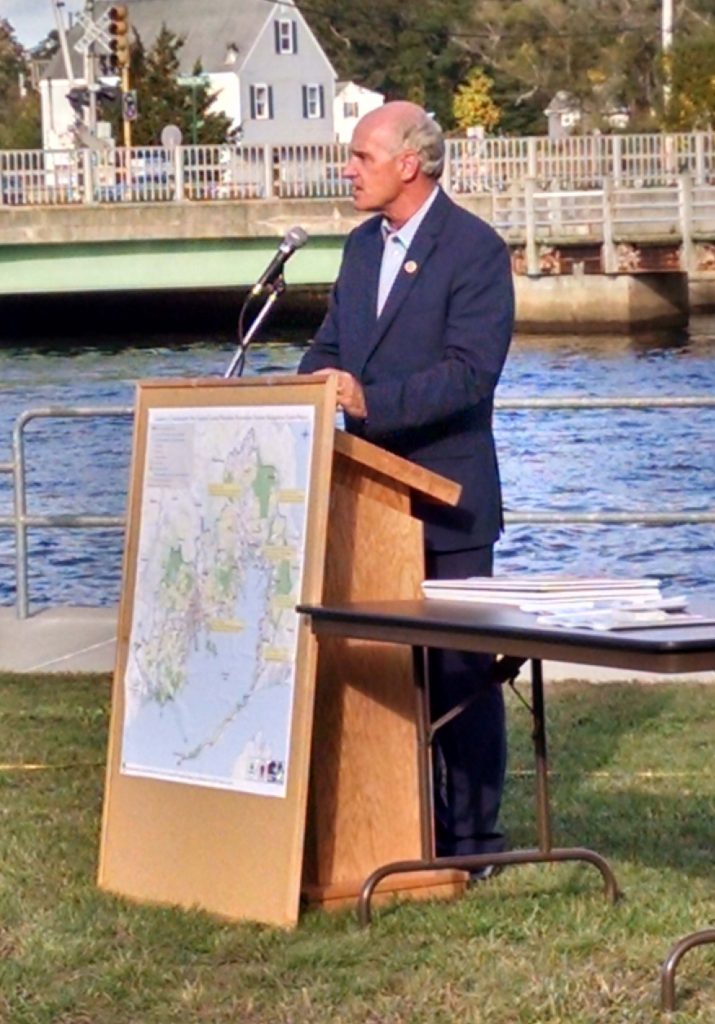
Congressman Bill Keating making remarks at EPA’s grant program program announcement.
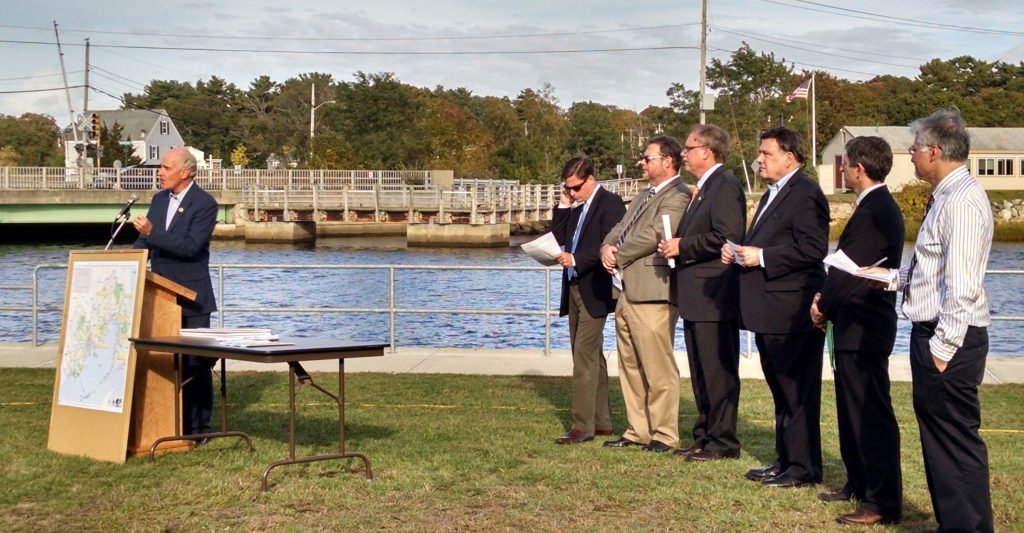
Other speakers included (left to right): Bruce Carlisle, Director of MA Coastal Zone Management was the master of ceremony. Wareham Selectman Peter Teitelbaum who made welcoming remarks, EPA Regional Administrator Curt Spalding who announced the new program, state Senator Marc Pacheco, DEP Commissioner David Cash, and Buzzards Bay Executive Director Joe Costa who described the grants.
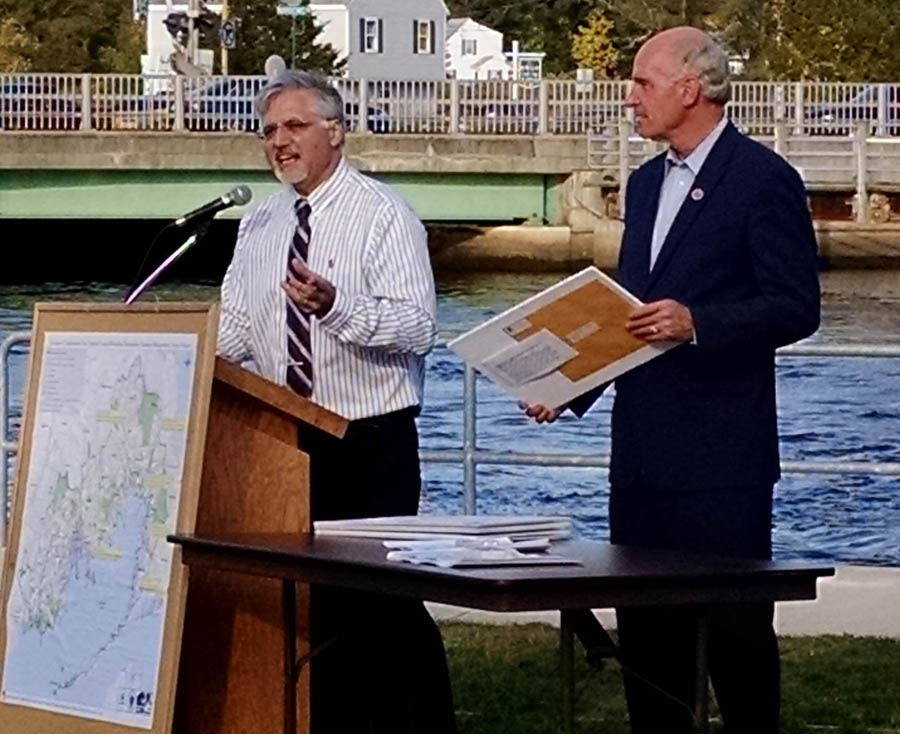
Buzzards Bay NEP Executive Director Dr. Joe Costa and U.S. Congressman William Keating about to hand out awards.
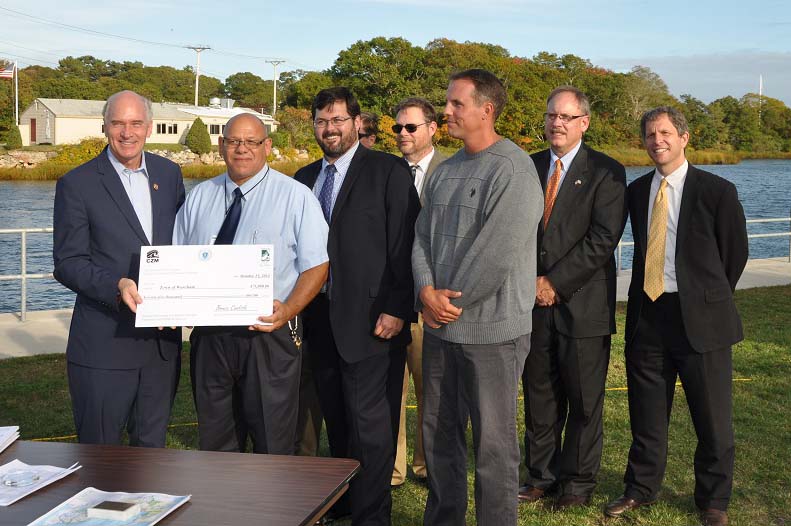
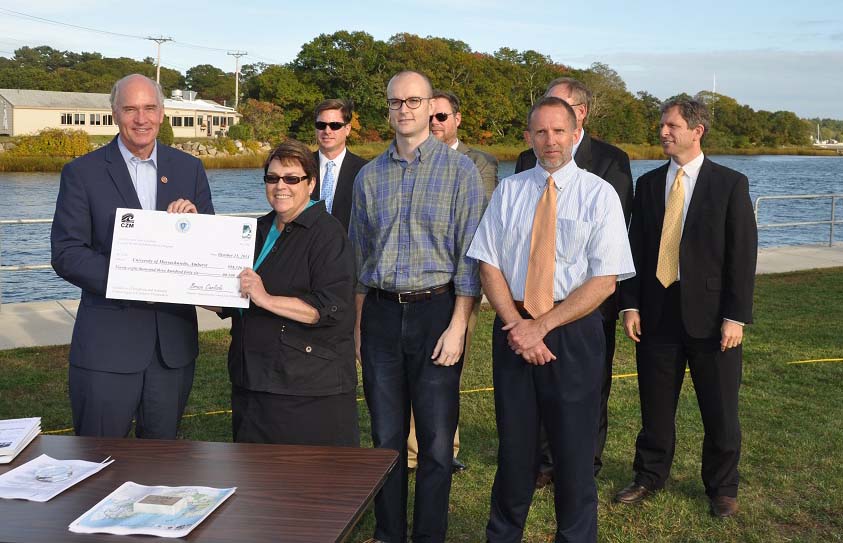
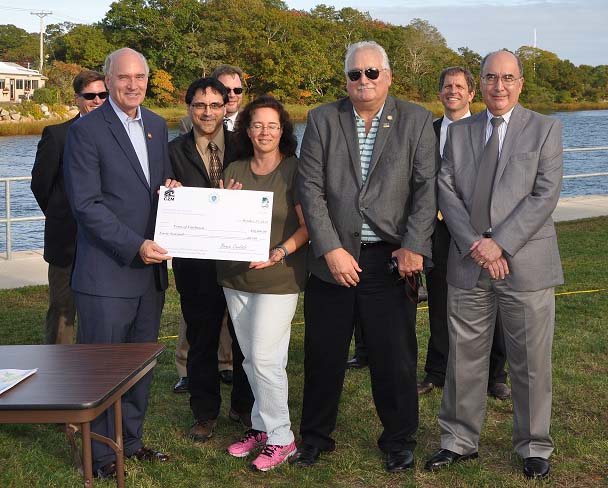
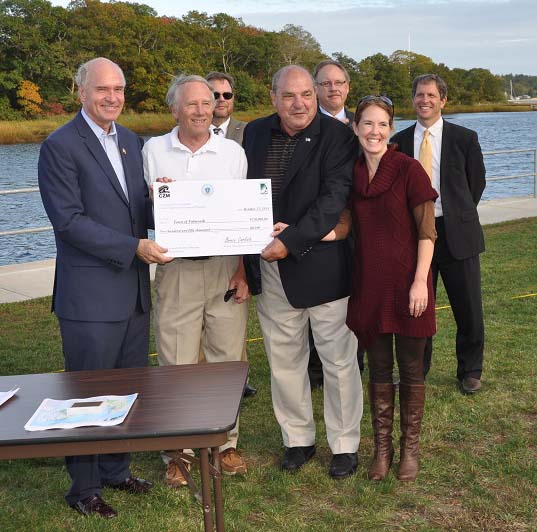
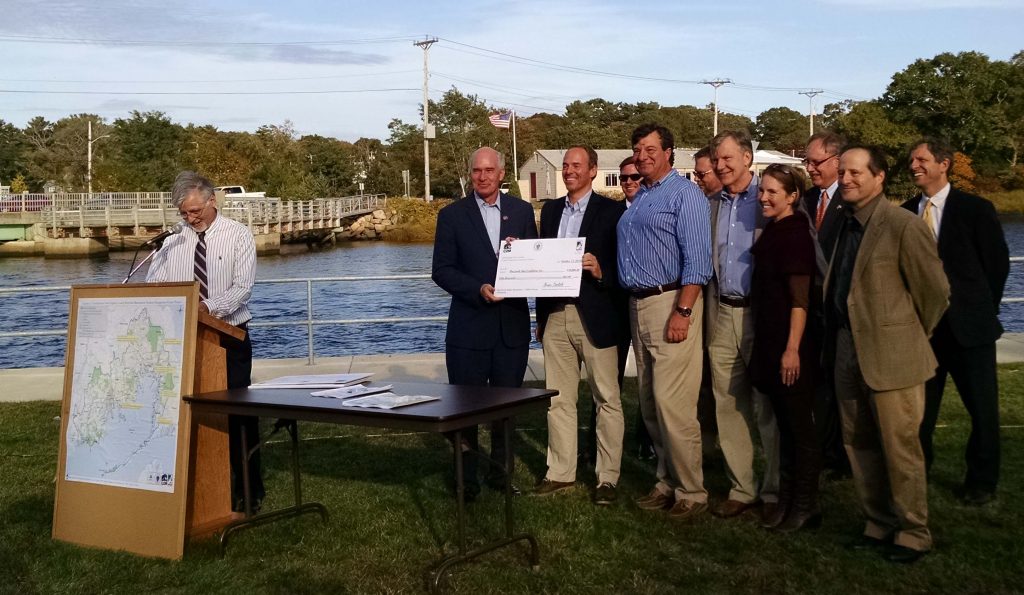
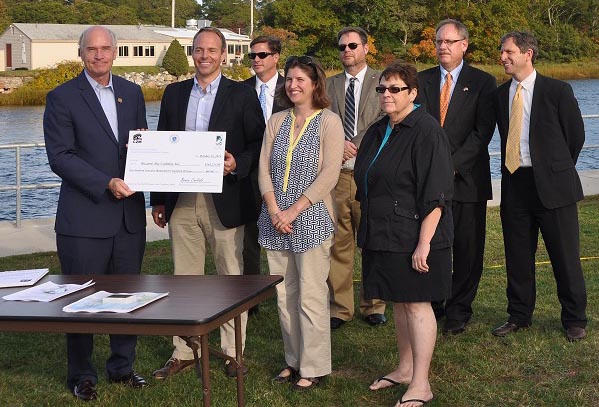
Cranberry Bog nutrient study project recipient and partners, from left to right: U.S. Congressman William Keating; Mark Rasmussen, President, Buzzards Bay Coalition; Dr. Rachel Jakuba, Science Director, Buzzards Bay Coalition; and Dr. Carolyn DeMoranville, UMass Cranberry Experiment Station.
The following projects were announced as funded in the Buzzards Bay watershed:
Gypsum as a Phosphorus and Sediment Control Agent in Cranberry Floodwaters
The University of Massachusetts, Amherst received $98,346 to develop a management practice to control phosphorus in the discharges of cranberry bog harvest floodwaters. When discharged to surrounding surface waters, phosphorous can cause water quality degradation by promoting excessive plant growth and reduced oxygen supplies. The use of gypsum and sulfur was evaluated as a tool to lower dissolved phosphorus discharges from the bogs studied.
Outcome: In field experiments there was no success removing phosphorus with gypsum. Modeling confirmed pH was a likely factor. Researchers undertook modeling and bench experiments with calcite (increases pH), which showed higher potential phosphorus removal. However, lab experiments showed that an impractically large amount of calcite would be needed to reduce phosphorus, which would also have pH implications. A third set of experiments was conducted to evaluate the phosphorus sorbing potential of aluminum sulfate (alum) and iron sulfate. Alum and iron sulfate were found to effectively remove phosphorus at application rates that are feasible for many growers. It was determined that alum is the most effective option, as it does not reduce pH as much as iron sulfate, which can impact cranberry production. Read the final report.
Nitrogen Reduction Pilot Study at the Fairhaven Municipal Water Pollution Control Facility
The Town of Fairhaven received $90,000 to evaluate several modifications to its wastewater treatment processes to reduce nitrogen concentrations at the Water Pollution Control Facility to meet new requirements. A pilot study was conducted at the plant to provide a framework for design and construction of new nitrogen reduction facilities.
Outcome: The Town piloted a “modified” 4-stage Bardenpho process with BioMag from Sept. to Nov. 2015. Magnetite was used as a ballast material to combine with biological floc in the aeration basins, with the entire plant flow in one aeration train. Unfortunately, there were no consistent reductions in total nitrogen due to several factors. The Town’s consultant determined that adjustments to the process may achieve the desired results. Other major issues were the costs and energy use of the system, in addition to damage that was caused to a clarifier rake arm from the heavier magnetite sludge. The Town has determined that the 4-stage Bardenpho process with BioMag is an effective option (with modifications), but the cost to build and operate system is too great for the Town. Read the final report.
Process Monitoring for Optimal Nitrogen Treatment and Outfall Reduction
The Town of Wareham Water Pollution Control Facility received $75,000 to implement an automated wastewater monitoring program to help the facility further reduce nitrogen discharges to the Wareham River estuary through the installation of state-of-the-art nitrogen monitoring equipment and process controls. The award funded a computerized network of monitoring probes will be installed to collect data in real time.
Outcome: The system was successfully installed and went online December 2015. The installed probes communicate with existing software at the water pollution control facility so that operators can have a streamlined view of the monitoring at each step of the process. The new system allows for fine tune adjustments of oxygen levels in the anoxic process and faster reaction time if there is a malfunction. Read the final report .
Red Brook Harbor Restoration – A Public-Private Partnership
The Buzzards Bay Coalition received $50,000 to develop engineering designs to tie in unsewered portions of the town into a sewerage treatment plant to be built surving a planned townhouse development (Red Brook Harborview) located in Cataumet Village in Bourne. The anticipated neighborhood-scale private wastewater treatment facility is required by the Town to have excess capacity to allow for connections from the Kingman Yacht Center and other neighborhood properties. This project developed sewer plans to tie in the neighboring 52-home Cedar Point development, into the planned private wastewater facility. The designs and future tie-ins would eliminate Title 5 systems and cesspools that are now degrading water quality. A legal entity will also be developed that can apply for state and federal financing to pay for the connections of the homes to the new wastewater treatment facility.
Outcome: Three sewer design scenarios were developed and two legal entities identified (private partnership vs. municipal sewer district). The applicant identified the preferred alternative as being the private partnership, which would contract with one or more of the homeowners associations. The project is continuing past life of grant, with public outreach to present plans and refine sewer layout as needed. Read the final report. Additional information about the effort can be found on this Buzzards Bay Coalition project update page.
Reducing Nutrient Releases from Cranberry Bogs
The Buzzards Bay Coalition received $165,213 to evaluate nutrient discharges from cranberry bogs to groundwater and surface waters. These discharges are a potential source of nitrogen pollution to coastal waters and phosphorus pollution to freshwaters. There is often uncertainty as to what loading rates to assign to cranberry bogs in nitrogen loading models to coastal watersheds used to establish nitrogen total maximum daily loads, so the Buzzards Bay Coalition, in partnership with the Marine Biological Laboratory and the University of Massachusetts Cranberry Experiment Station, studied the release of nitrogen and phosphorus from cranberry bogs to better understand these nutrient loadings.
Outcome: Three bogs were used in the study that are typical of the size, age, configuration, and condition of other cranberry bogs in the region. This study conducted the most detailed measurements made yet of surface water exchanges of nitrogen and phosphorus during cranberry bog water management and non-flood periods. It was determined that a 1-ha cranberry bog would be approximately equal to the nitrogen watershed contribution generated by one single-family home on a septic system. All bogs in the study were net sources of phosphorus to surface waters. Read the final report. This grant award helped leverage additional funding for continued research as described on this Buzzards bay Coalition project update page.
West Falmouth Harbor Shoreline Septic Remediation Project
The Town of Falmouth received $250,000 for an effort to replace existing Title 5 septic systems or cesspools on properties located within 300 feet of West Falmouth Harbor with innovative alternative nitrogen removing septic systems . The intent of the effort was to help the town meet water quality standards for West Falmouth Harbor. The Town of Falmouth undertook the initiative in partnership with the Buzzards Bay Coalition. Town and the Coalition worked with the West Falmouth Village Association to secure commitments from property owners and provide grants to homeowners of up to $10,000 to upgrade their systems. Grant funds were also used to also monitor the performance of the installed systems.
Outcome: The Town of Falmouth and the Buzzards Bay Coalition worked with property owners to replace the existing Title 5 septic systems and cesspools of 20 properties located within 300 feet of West Falmouth Harbor with denitrifying septic systems. None of the participants chose to install eco-toilets (either composting or urine-diverting systems). The following systems were installed: ten (10) Blackwater holding tanks, six (6) HOOT nitrogen-removing systems, one (1) Layer cake nitrogen-removing system, and three (3) Eliminate nitrogen-removing systems. Due to construction delays, no monitoring was able to be completed before the contract ended. $50,000 in grant funds were unused and will be dedicated to a future Buzzards Bay National Estuary Program grant round. Read the final report. This project helped prompted new legislation expanding the types of systems allowed under local betterment financing programs. Updates about the effort, and how it has continued in other parts of Buzzards Bay are described on the Buzzards bay Coalition webpages: page 1, page 2, and page 3.